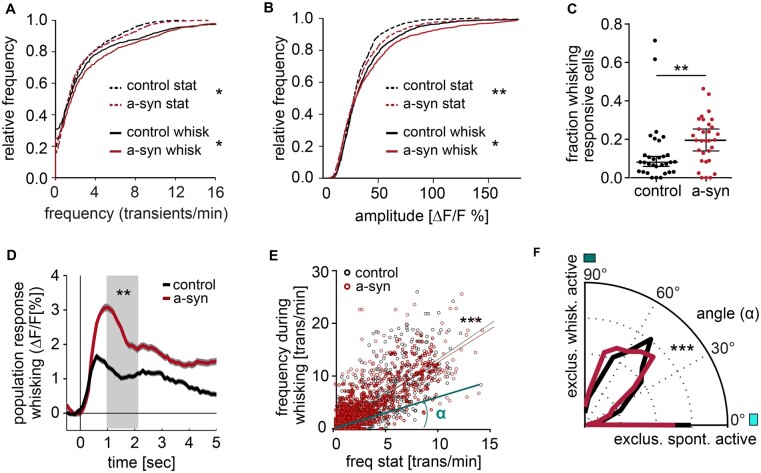Figure 2.
Neuronal hyperreactivity in S1 upon striatal injection of a-syn PFFs. (A) Calcium transient frequency in S1 is increased in a-syn mice both during quiescence (stat) as well as during whisking-associated epochs [stationary epochs, frequency P = 0.016, whisking-associated frequency P = 0.011, both Kolmogorov–Smirnov (KS) test]. (B) Transient amplitudes during quiescence (stat) and during whisking-associated epochs are larger in a-syn mice (stationary epochs, amplitudes P = 0.0019, amplitudes during whisking, P = 0.02, both KS test, control n = 1561 ROIs, a-syn n = 1534 ROIs). (C) Fraction of whisking responsive neurons in each experiment (P = 0.003, ranksum test, control n = 32 experiments, a-syn n = 32 experiments). (D) Population response of neurons to whisking onset (control: 1561 neurons, a-syn 1534 neurons). (E) Relationship of the stationary neuronal frequency and the activity associated with whisking in control (black, n = 1561 neurons) and a-syn mice (red, n = 1534 neurons, control R2 = 0.63, y = 1.36x − 0.07; P < 0.0001; a-syn R2 = 0.63, y = 1.26x + 0.44, P < 0.0001). To compare state-specific neuronal activity levels, the angle α was computed for each neuron, as exemplified for one neuron (light blue line and angle). (F) The distribution of these angles is significantly different in a-syn mice, with more neurons favouring activity during whisking epochs [angle of 0° indicates neuronal activity exclusively during stationary (quiescent) epochs, while 90° would indicate exclusive whisking-associated neuronal activity, P < 10−4, KS test]. Data are mean ± standard error of the mean (SEM). **P < 0.01, ***P < 0.001

